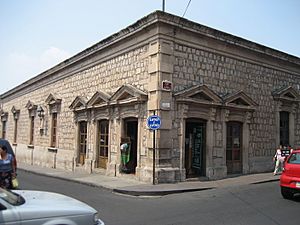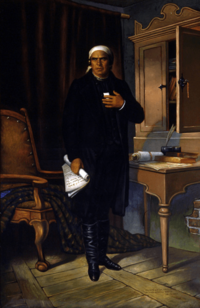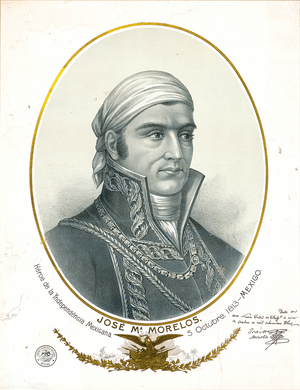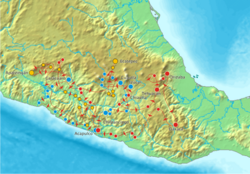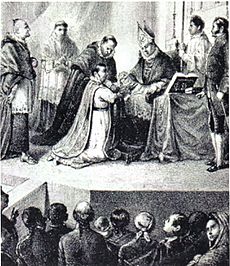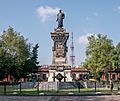José María Morelos facts for kids
Quick facts for kids
José María Morelos
|
|
|---|---|
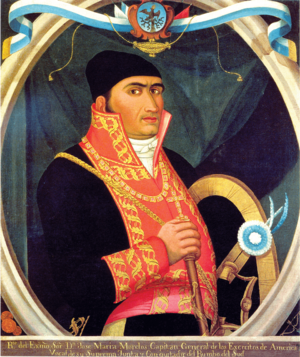
Morelos, painted by an unknown Mixtec artist
|
|
| President of the Supreme Mexican Government | |
| In office 24 October 1814 – 5 November 1815 |
|
| Preceded by | Post established |
| Succeeded by | Ignacio Alas |
| Chief of the Congress of Anáhuac | |
| In office 15 September 1813 – 24 October 1814 |
|
| Preceded by | Post established |
| Succeeded by | Himself as president under the Constitution of Apatzingan |
| Member of the Council of Zitacuaro | |
| In office 19 August 1811 – 15 September 1813 |
|
| Personal details | |
| Born | 30 September 1765 Valladolid, Michoacán, New Spain |
| Died | 22 December 1815 (aged 50) San Cristóbal Ecatepec, State of México |
| Resting place | Angel of Independence, Mexico City |
| Children | Juan Nepomuceno Almonte |
| Alma mater | Universidad Michoacana de San Nicolás de Hidalgo |
| Profession | Arriero, Priest, Military leader, Politician |
| Signature |  |
| Military service | |
| Allegiance | Mexico |
| Branch/service | |
| Years of service | 1810–1815 |
| Rank | Generalissimo, Captain General, Colonel |
| Battles/wars | Mexican War of Independence |
José María Teclo Morelos Pérez y Pavón (born September 30, 1765 – died December 22, 1815) was a Mexican Catholic priest, a leader, and a military commander. He led the Mexican War of Independence movement. He took over the leadership after Miguel Hidalgo y Costilla was executed in 1811.
Morelos was born in Valladolid, which is now called Morelia. He studied at the Colegio de San Nicolás. In 1799, he became a priest in Carácuaro. He joined Miguel Hidalgo's call for independence, known as the Cry of Dolores. Soon, he became an important leader in the fight for freedom.
With help from local people and other revolutionary leaders like Mariano Matamoros and Ignacio López Rayón, Morelos captured areas in southern and central New Spain. He led the important Siege of Cuautla and captured Acapulco, which was New Spain's main port on the Pacific Ocean. His actions inspired many others to join the fight against Spanish rule. This made him the main opponent of the Spanish royal army.
In 1813, Morelos wrote a famous document called Sentimientos de la Nación (Feelings of the Nation). This paper was inspired by the Constitution of Cádiz. It explained his plans for an independent Mexican nation. Under his leadership, the Congress of Anáhuac was formed in Chilpancingo. On November 6, 1813, they officially declared Mexico's independence. On October 22, 1814, the Constitution of Apatzingán was written by the Congress. It stated that Mexico would be a Republic.
After several defeats, the Spanish royal army captured Morelos in Temalaca, Puebla. He was put on trial by the Inquisition, which was a church court. He was removed from his role as a priest and then executed by the government in San Cristóbal Ecatepec on December 22, 1815. Morelos is remembered as a national hero in Mexico. Even though he wasn't a trained soldier, he became a very successful leader who helped organize and strengthen the War of Independence. The Mexican state of Morelos and the city of Morelia are named after him.
Contents
Early Life and Education
José María Morelos was born in Valladolid, which is now called Morelia. His family was considered Spanish at the time. His father, José Manuel Morelos y Robles, was a carpenter. His mother, Juana María Guadalupe Pérez Pavón, was from a nearby town. Valladolid was a wealthy city, known as the "Garden of the Viceroyalty of New Spain".
Morelos was related to Miguel Hidalgo y Costilla, another important leader of the independence movement. They shared a common ancestor, Diego Ruiz de Cortés.
Before becoming a priest, Morelos worked as a arriero, or muleteer. This job involved moving goods using mules. Working in this area gave him valuable knowledge of the land, which helped him later during the war. He also worked on a ranch for about ten years.
Morelos wanted to do more than manual labor. He studied hard, as his grandfather was a school teacher. In 1789, he joined the Colegio de San Nicolás Obispo in Valladolid. Miguel Hidalgo y Costilla was the head of this school at the time. After becoming a priest, Morelos did not take a vow of poverty. This meant he could still do business to support himself. He had children, including a son named Juan Nepomuceno Almonte, who later became important in Mexican history.
Fighting for Independence
Miguel Hidalgo y Costilla, Morelos's former teacher, was planning to make New Spain independent from Spain. On September 16, 1810, Hidalgo, a parish priest, rang the church bells in Dolores. He gathered his community and urged them to fight for freedom. This event is known as the Cry of Dolores (El Grito de Dolores). It marked the start of the Mexican War of Independence.
The Spanish government was surprised by the rebellion. The rebels quickly took important cities in the Bajío region. Hidalgo was named the leader of the Mexican forces. On September 28, the rebels captured the Alhóndiga de Granaditas in Guanajuato. Many Spanish soldiers were killed there.

The bishop of Michoacán officially removed the rebels from the Catholic Church. Hidalgo's army then marched to Valladolid. The city was taken peacefully on October 17, 1810. Morelos heard about the revolt and decided to join. He met Hidalgo in Indaparapeo. Hidalgo asked Morelos to gather troops in the south and capture the port of Acapulco. Acapulco was very important for trade with the Philippines.
Unlike Hidalgo, who led a large but often disorganized army, Morelos quickly showed great military skill. He gathered and trained a small group of fighters. He found allies in the region and got cannons and other war supplies. Morelos wanted to create a republican government where all Mexican people could participate. He also wanted to end slavery and remove differences between races and ethnic groups.
Morelos's Military Campaigns
Morelos proved to be a very skilled military leader. In his first nine months, he won 22 battles. He defeated three Spanish royalist armies and captured almost all of what is now the state of Guerrero. In December, he captured Acapulco for the first time, except for the Fort of San Diego. Spanish reinforcements forced him to stop the attack in January. But with quick movements, he captured most of the Spanish areas on the Pacific coast of Michoacán and Guerrero. On May 24, 1811, he took Chilpancingo, and on May 26, he took Tixtla.
In his second campaign, Morelos divided his army into three groups. A very important battle was at Cuautla. On Christmas Eve 1811, the people of Cuautla welcomed Morelos. The next year, his forces were surrounded by the Spanish army led by General Félix María Calleja del Rey. On May 2, 1812, after 58 days, Morelos broke through the Spanish siege. This allowed him to start his third campaign.
Key victories in this third campaign included Citlalli (June 8, 1812), Tehuacán (August 10, 1812), Orizaba, Oaxaca, and Acapulco. Morelos arrived at Orizaba with 10,000 soldiers on October 28, 1812. The city was defended by 600 Spanish soldiers. After talks, the city surrendered without a fight. He entered Oaxaca in victory on November 25, 1812. Acapulco fell on April 12, 1813. The Spanish army had to hide in the Fort of San Diego.
The Congress of Chilpancingo
In 1813, Morelos called for the National Constituent Congress of Chilpancingo. This meeting included representatives from the areas he controlled. They met to discuss a plan for a new government and society. Morelos presented his ideas in a document called Sentimientos de la Nación (Feelings of the Nation). The Congress called itself the Congress of Anáhuac, a name referring to the Aztecs.
On September 31, 1813, the Congress, with Morelos present, approved the Sentimientos de la Nación. This document declared Mexico's independence from Spain. It made Catholicism the official religion. It also created the three branches of government: legislative, executive, and judicial. It said that property should be respected. It also ended slavery and racial categories, calling all native-born people "American." Torture, colonial monopolies, and the system of tributes were also abolished. Morelos was offered the title "Generalissimo" and "Your Highness." But he refused these titles. He asked to be called "Siervo de la Nación" (Servant of the Nation) instead. On November 6, 1813, the Congress declared independence in the Solemn Act of the Declaration of Independence of Northern America.
After some military losses, the Congress met in Apatzingán. On October 22, they announced the "Decreto Constitucional para la Libertad de la América Mexicana" (Constitution of Apatzingán). This constitution created a strong legislature and a limited executive. This was different from what Morelos had wanted. However, he accepted it as the best plan they could make at the time.
Capture and Execution
Soon after, Morelos began his fourth military campaign. This campaign started with defeats in Valladolid in late 1813. In November 1815, while protecting the new Congress, he was defeated in Temalaca by the royalist forces. Morelos and his guards were surrounded. To save his men, Morelos told them to escape. This left Morelos to be captured alone.
Because he was a Catholic priest, the church had the right to imprison and try him first. He was held in the Inquisition building in Mexico City. The Spanish government saw Morelos as a very important capture. However, the viceroy decided to bring him into the capital quietly, before dawn.
The church officials made 23 charges against Morelos. He had a defense lawyer, José Quiles. He was accused of treason and disloyalty to the Spanish crown. He was also charged with personal matters, like sending his children to the United States for education.
He was tried and sentenced to death for treason. Morelos was executed by a firing squad on December 22, 1815. This happened in San Cristóbal Ecatepec, north of Mexico City. This location was chosen so his execution would not cause a large public reaction. Before his death, he was seen praying. After his death, his trusted officer, Vicente Guerrero, continued the fight for independence.
Legacy and Remembrance
Morelos is seen as a national hero in Mexico. The state of Morelos and the city of Morelia are named after him. His image has been on the 50-peso note since 1997. He was also on 1-peso coins in the 1940s, 1970s, and 1980s.
Many places are named after him, including the Estadio Morelos in Morelia, Puerto Morelos in Quintana Roo, and the Morelos Station on the Mexico City Metro. The city of Ecatepec de Morelos, where he was executed, is also named after him. The Insurgente José María Morelos y Pavón National Park in Michoacán and the Morelos Satellite are also named in his honor. His remains were moved to the Angel of Independence monument in Mexico City, along with other heroes of the independence movement.
Images for kids
-
The Angel of Independence in Mexico City, where Morelos's remains are kept.
See also
 In Spanish: José María Morelos para niños
In Spanish: José María Morelos para niños


